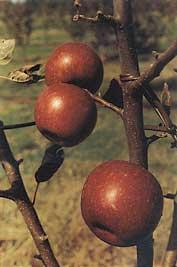Conserving, remembering or presalising old fruit trees?
In the area of Abbadia are concentrated one hectare of fruit trees that were formerly cultivated mainly in the North Basque Country and Biarnon. This seminar is part of the Conservatory of Plants of Aquitaine.
Lost Heritage
Managers of seedlings, forestalists and farmers have abandoned the cultivation of native varieties and have opted for new varieties.
Each province of Aquitaine, less than 20 years ago, had a fruit production oriented to regional and national sales. The same thing happened to Itsasun, in the canton of Ezpeleta.

Unfortunately, most of the varieties of apple trees collected and studied by the National Institute of Agronomic Research between 1945 and 1960 have disappeared from the plantations of apple trees and seedlings, while others only have isolated specimens.
To combat the impoverishment of rural heritage it was decided to create a plant conservatory.
Before it was too late it was necessary to collect the most representative or minority varieties.
Activities in the Conservatory of Fruit Varieties
* Inventories and descriptions
While initial prospecting was done in such a way, now people who contact the Conservatory of Fruit Varieties have interest or know ancient varieties.
This has allowed to complete a large number of samples with descriptions of species and photographs. More than 500 apple chips, for example, are in the files.
Not only are they kept but they are better known.
* Research papers
To discover the agronomic and genetic advantages and weaknesses of these unknown varieties, numerous research is being carried out: the behavior of the fragile plant leaf; granulation; white; red fire; the study of flowering...

Several laboratories participate in this research; some directly, others advising and others lending their material
* Educational activities
The Conservatory of Fruit Species organizes annually and to the public courses of ageing, pruning, fertilizing or parasiting.
* Diffusion of plants
Along with the conservation of the species, it is very important to revegetation the plants that were formerly in the mountain fields.
In the Conservatory some of these species grow for later sale.
Current collections
The Conservatory of Fruit Species of Aquitaine, since 1982, is located in the ecomuseum of Sabe, in the center of the Regional Natural Park of Landeta.
Today it brings together more than 1,000 varieties, of which 600 are apple trees (80% of Aquitaine origin).
However, it is advisable to duplicate the collections to avoid their total or partial disappearance (bacterial diseases, weather accident,...) and to know better the agronomic value of these clones.
In this way, we have seen the need for each species of this collection of species to grow in a specialized conservation plot located in its territory of origin.
Since 1988, the collection of Basque and bearnesas species has doubled since the creation of the Plant Conservatory “Zona de Abbadia”.
Plant Conservatory of the Abbadia area

Taking advantage of the cessation of maize production in a land well protected from the winds of the northwest (strong wind, salinity) and in order to enrich its biological and heritage values, in late 1988 the Plant Conservatory of Basque and Biarnoan Species was created. At the end of 1989 the conservatory was extended.
This new plant now has more than 500 trees, among which are more than one hundred varieties of apple trees, more than fifty types of cherry, plum, peach, mizpiros and even vine.
The plantation system used is the one corresponding to the vegetation with plastic coating (only soil) and green manure.
Although the plastic coating is not aesthetic, its advantages must be taken into account: it limits the growth of weeds, hinders erosion in steep soils, heats the soil slowly, prevents soil compaction due to rains, limits evaporation in droughts, favors terrestrial microfauna and ventilation.
The green fertilizer (where all organic matter remains and is regularly buried) delimits the lysis phenomena produced by certain mineral elements. Therefore, burial and periodic passage are methods to enrich the soil. Unlike the rest of the area, it contributes to the growth of botanical diversity.
The trees are driven by a pruning called “low thimble shape”. Although the most common thing in Euskal Herria has been the “form for the four winds”, the proximity to the coast has forced to cope with the harmful effects of the wind.
Despite its recent opening, the Plant Conservatory of the area of Abbadia participates in the conservation of its heritage, not only preserving ancient varieties and collective consciousness, but also showing a wide audience.





